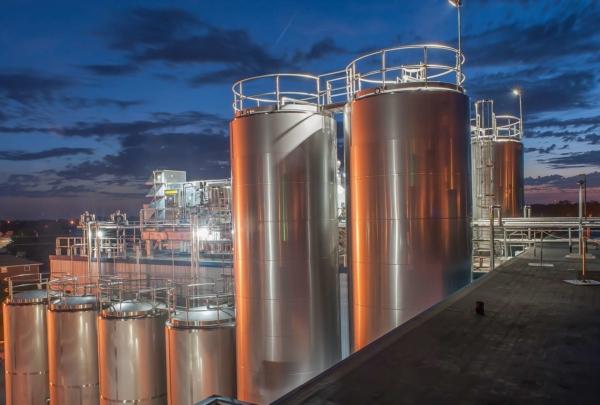Here’s a question most consumers don’t ponder when biting into their favorite greasy cheeseburger: How much water did it take to make this?
However, for food and beverage producers, water consumption grows more critical by the day. An increased need for water conservation and a sharpened focus on sustainability mean manufacturers must consider ways to save water and save money while still delivering a high-quality product.
According to the Sierra Club, it takes 698.5 gallons of water to produce the average cheeseburger. That includes 22 gallons to make the bun, 4.5 gallons to grow the lettuce and tomato, 56 gallons to produce one slice of cheese and a whopping 616 gallons, from start to finish, to make the meat patty. In an economy where the average price of water is about $4.50 per 1,000 gallons, the costs can add up for food and beverage producers, not to mention the environmental impacts.
Food Industry Expertise
澳门足彩app has been ranked in the Top 5 of Engineering News-Record’s Food & Beverage Manufacturing Contractors for the past 12 years, including seven consecutive years in the Top 2. Our expertise spans the grocery aisles, from emerging sustainable proteins and pre-packaged food service items to confectionery sweets and baked snacks.
So, how can food and beverage producers conserve water in the food and beverage industry? The 澳门足彩app team, including our experts at Seiberling, a 澳门足彩app Company, has four suggestions for reducing water consumption.
1. Optimize Clean-in-Place (CIP) Technology with a Centrally Located CIP Room.
When planning a greenfield project or significant facility upgrade, the location of the CIP room is critical to conserving water and energy. The shorter the distance water travels from its source to the equipment and back for disposal, the better.
Producing one gallon of milk requires about 880 gallons of water, including 1.2 to three gallons used in the final processing. Given that over 10 billion gallons of milk are consumed in the U.S. each year, that adds up to 21 billion gallons of water — 50% of which is used to CIP the 1,300 dairies in the U.S.
“CIP systems are the largest consumer of water in a facility,” Process Subject Matter Expert Robert Price said. “Supply and return piping systems are filled several times per cleaning cycle every day, so the farther away the CIP room is from the equipment, that adds to the volume of water required to complete each cycle.”
By centrally locating a CIP room or placing multiple CIP rooms within a facility to reduce the volume and traveling distance of valuable water resources, plants can save $124,000 a year in water costs, treatments, chemicals and energy usage. It also saves 330 hours a year in time spent running CIP cycles.
2. Use Properly Sized Pipes and Product Recovery Systems
While having a centrally located CIP room reduces the linear feet of piping needed to carry water to and from equipment, making sure the plant’s piping system for CIP and processing is sized correctly also has a tremendous impact on the cost and consumption of water.
“In a greenfield facility, it’s important to make sure that the line sizing and pressure are economized for your system,” Price said. “Most of the time, a two or a two-and-a-half-inch line can do the same job as a three-inch line in a shorter time, with less water.”
Take, for example, an ice cream facility that mixes pasteurized lines from storage tanks to freezer centers. With over 6,500 feet of piping needed to complete the process, the difference between 3-inch diameter and 2.5-inch pipes in the water required to properly clean excess product from the system is 2.1 million gallons per year.
3. Use Other CIP Systems to Remove Excess Product
The oversized pipes also resulted in an additional 350,000 gallons of product each year wasted in the CIP process. Allowing that product to get washed out in the rinse water sends profits down the drain. Instead, other options like air blows and water flushes can help plants reclaim up to 90% of the product still in the lines with minimal water consumption.
Removing the residual product for use also minimizes the amount of water and time needed for the CIP system to clean the lines after each processing cycle. It’s a win-win that provides plants with more product to sell and reduced expenses due to reduced water consumption.
4. Embrace New CIP Technology
Advances are made daily in CIP systems that help reduce the amount of water needed to clean and sanitize equipment properly. New turbidity sensors can measure the opacity of rinse water to determine precisely when dairy residue has been safely eliminated.
“Even existing plants can be optimized to clean equipment more efficiently,” says Price. “Rinse times used to be set up based on volume, but if your products change in viscosity that doesn’t always work because you’re set up for the heaviest product, like yogurt, which then creates an overuse for something lighter like milk. Newer CIP systems can be tailored to each product.”
Price also points out that simple housekeeping measures, like checking for leaky gauges and valves, can often save water and resources.
If you have a food or beverage production facility, it’s worthwhile to look closer at your water consumption levels and identify areas where you can save time and money with conservation.
“Optimizing CIP systems goes beyond water consumption,” he said. “It also reduces the amount of downtime for equipment while it’s going through the cleaning process. Downtime leads to revenue loss, so that’s a big area where we are working to find new ways to make CIP more efficient, without sacrificing safety or quality.”
澳门足彩app’s process engineering team provides best-in-class solutions for some of the world’s largest food and beverage producers. Contact us to reduce waste in your new or existing facility.








































